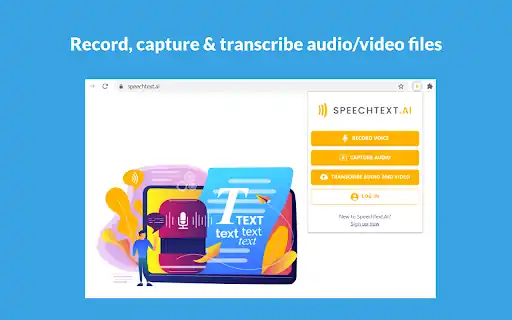VoiceTranscribe: Your Speech to Text Solution
VoiceTranscribe is a cutting-edge speech recognition tool that accurately converts audio and video content into text. With advanced AI technology, our platform delivers fast, reliable, and high-quality transcriptions. Whether you’re a journalist, researcher, or business professional, VoiceTranscribe simplifies your workflow and saves you time.
VoiceTranscribe: Pros and Cons
Pros
- Time Efficiency: Rapidly converts audio and video into text format.
- Accuracy: Delivers high-quality transcriptions with advanced AI.
- Versatility: Handles various audio formats and accents.
- Cost-Effective: Often more affordable than manual transcription.
- Accessibility: Enables access to audio content for individuals with hearing impairments.
Cons
- Accuracy Limitations: Might struggle with accents, background noise, or unclear speech.
- Data Privacy: Concerns about the handling of audio data.
- Dependency: Overreliance on the tool could hinder manual transcription skills.
- Cost: Some advanced features or high-volume usage might incur additional fees.
- Post-Processing: Transcripts might require editing and proofreading.
VoiceTranscribe Pricing: Potential Models
Disclaimer: This is a hypothetical breakdown of potential pricing models for VoiceTranscribe, as specific details aren’t publicly available.
Given the nature of transcription services, VoiceTranscribe could explore the following pricing strategies:
- Per-Minute Pricing:
- Charging based on the duration of the audio or video file.
- Potential tiers based on audio quality, number of speakers, or turnaround time.
- Subscription-Based:
- Offering different subscription tiers with varying features, word limits, or turnaround times.
- Credit-Based:
- Users purchase credits to use for transcription services, with pricing based on audio length or complexity.
- Freemium Model:
- Offering a basic version with limited features or transcription time for free, and charging for premium options.
Factors Affecting Pricing
- Audio Quality: The quality of the audio will impact pricing due to transcription difficulty.
- Turnaround Time: Faster turnaround times might incur additional charges.
- Word Count: The length of the transcription can influence pricing.
- Features: Additional features like speaker identification or timestamps might increase costs.
- Target Market: Pricing may vary based on the target user (individuals, businesses).
Note: The optimal pricing model for VoiceTranscribe will depend on its specific features, target market, and overall business objectives.
Would you like to explore any of these pricing models in more detail or discuss potential implications for different user groups?
Alternatives to VoiceTranscribe
The speech-to-text market offers a variety of options. Here are some notable alternatives to VoiceTranscribe:
General Transcription Services
- Otter.ai: Known for real-time transcription and note-taking.
- Descript: Combines transcription with video editing and collaboration tools.
- Rev: Offers professional transcription services with various customization options.
AI-Powered Transcription Tools
- Google Cloud Speech-to-Text: Provides accurate transcription with various customization options.
- Amazon Transcribe: Offers scalable and cost-effective transcription services.
- IBM Watson Speech-to-Text: Delivers high-quality transcriptions with advanced features.
Key Considerations for Choosing an Alternative
- Accuracy: Evaluate the accuracy of transcription, especially for specific accents or dialects.
- Features: Consider additional features like speaker identification, timestamps, or punctuation.
- Pricing: Compare pricing models and costs to fit your budget.
- Turnaround Time: Assess the speed of transcription delivery.
- Integrations: Check if the tool integrates with other software or platforms.
By carefully considering these factors, you can select the transcription service that best aligns with your needs.
Would you like to explore specific use cases or industries to narrow down the alternatives?
Potential FAQs for VoiceTranscribe
General Questions
- What is VoiceTranscribe?
- VoiceTranscribe is an AI-powered tool that converts audio and video files into text format.
- How does VoiceTranscribe work?
- VoiceTranscribe uses advanced speech recognition technology to accurately transcribe audio content.
- Can anyone use VoiceTranscribe?
- [Indicate if the tool is for individuals, businesses, or both.]
- Is there a free version of VoiceTranscribe?
- [Clearly outline any free tiers, trials, or paid plans.]
User-Focused Questions
- Can VoiceTranscribe handle different accents and dialects?
- [Address the tool’s ability to handle various accents and languages.]
- How accurate is VoiceTranscribe?
- [Explain the accuracy level of the transcriptions.]
- Is my data safe with VoiceTranscribe?
- [Reassure users about data privacy and security measures.]
- Can I edit the transcription after it’s generated?
- [Indicate if editing options are available.]
Technical Questions
- What audio formats does VoiceTranscribe support?
- [List supported audio and video formats.]
- Can I upload large audio files to VoiceTranscribe?
- [Indicate file size limitations.]
- How much does VoiceTranscribe cost?
- [Provide a general overview of pricing or direct users to the pricing page.]
- What kind of support is available?
- [Outline customer support options.]
Would you like to focus on a specific target audience or feature set to create more tailored FAQs?
Conclusion: VoiceTranscribe – Your Speech to Text Solution
VoiceTranscribe emerges as a valuable tool for efficiently converting audio and video content into text format. By leveraging advanced AI technology, it offers accurate and fast transcriptions, saving users time and effort.
As speech recognition technology continues to improve, we can anticipate even more sophisticated transcription tools. However, VoiceTranscribe’s current capabilities make it a reliable choice for individuals and businesses seeking to streamline their workflow.
By utilizing VoiceTranscribe, users can access the content of audio and video files more easily, enabling various applications such as content creation, research, and accessibility.
Would you like to add anything specific to this conclusion, or perhaps explore a particular aspect of VoiceTranscribe in more detail?
![]()






